Pesarattu recipe, Andhra pesarattu recipe or pesara dosa recipe.
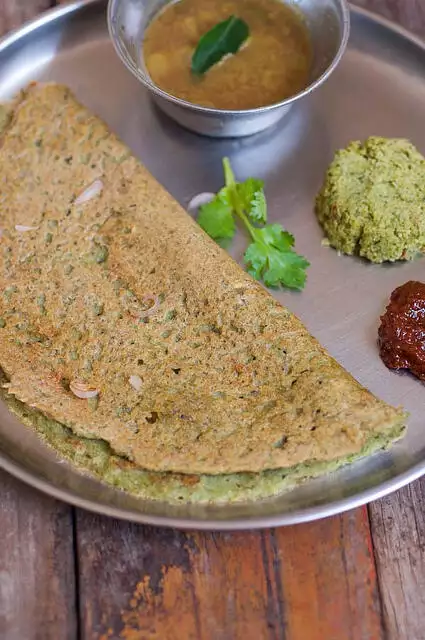
What is Pesarattu?
Pesarattu is a dosa variety made with some simple ingredients – whole green moong, rice, cumin, ginger, and some spices added to taste.
The thickness of pesarattu can be customised to preference. My parents like it on the thicker side and so growing up, I have always had it thick with crispy edges, cooked in a generous amount of oil. While this is delicious, my favourite quickly turned into the thinner pesarattu they served in a favourite South Indian restaurant during my time in Hyderabad. The word pesaralu translates to moong dal in Telugu, which is something else I learned too.
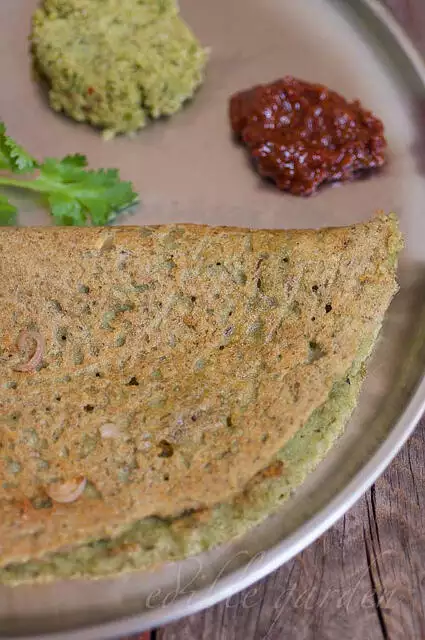
Is Pesarattu healthy?
Pesarattu can be just the thing if you are looking for a hit of protein in your diet. Yes, moong dal has carbs too but also packs a mean protein punch and so pesarattu can be added to your diet for a balanced meal or even weight loss, if you are vegetarian, especially.
I have tried the same recipe without addition of any rice so you can reduce the carb content even further. The dosa can be more dry and dense in this case but if you eat hot, it is still really good and may aid your weight loss goals.
The fact that we use whole green moong dal also means there’s extra fibre from the skin of the dal and from the added cumin seeds which help with digestion and also making you feel full for longer.
One thing I have heard is that if you have kidney or gall bladder issues, avoid too much moong dal. I am not a medical professional so please do your due diligence before consuming any food extensively. Anything in moderation should be fine.
What is the difference between dosa and pesarattu?
Dosa, the traditional kind, uses rice and skinned urad dal which is white. Typically we don’t add any spices or other ingredients to the dosa batter and leave it to ferment for a soft texture for sofa.
Pesarattu, on the other day, uses green moong dal and rice along with other spices and ingredients. There’s no need to ferment or rest the batter after grinding, you can cook pesarattu immediately. The texture is not as spongy as typical dosa.
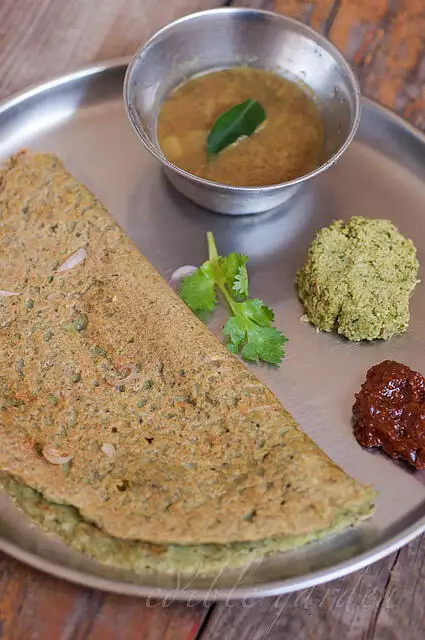
Paired with the tiffin sambar, coconut coriander chutney and ginger chutney or Andhra allam pachadi, pesarattu is quite a treat!
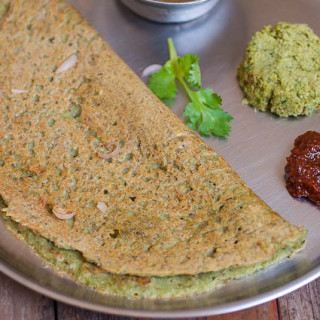
Andhra Pesarattu Recipe
Ingredients
- 1 cup whole green moong
- 1/4 cup of raw rice
- A small piece of ginger
- A small bunch of coriander leaves cilantro
- 2 cloves of garlic optional
- 1-2 green chillies adjust based on heat
- 2 tbsp of oil for drizzling on dosa while cooking
- 1/4 cup of minced onions for garnish optional
Instructions
- Soak the moong dal and rice together for at least 4 hours or overnight if possible.
- Grind together with rest of the ingredients and some salt + water
- The batter will be coarse and you can adjust the thickness to your preference, not making it too watery.
- Heat a tawa and spread 1/2 cup of batter into a circle.
- Spread it thinner for a crisper version, it’s entirely up to you. Drizzle with some oil and spread the minced onions on top (if using).
- Flip over when the first side is cooked. You can also cover and cook the dosa without flipping over, especially if you are serving the pesarattu with an upma filling (check notes).
- When both sides are cooked, remove from tawa and serve hot
Notes
- Pesarattu is sometimes served with a filling of rava upma. You can add a mound to the centre of the dosa after pouring the dosa and cook it covered for a few minutes
- Pesarattu batter keeps in the refrigerator for up to 2 days
- For a more nutritious pesarattu, use moong dal sprouts instead of the whole beans
- You can add rice flour instead of raw rice but grinding the rice along with the dal gives a coarse texture to the pesarattu which I personally love
- The texture of the batter should be a bit thicker than regular dosa batter
Step by Step Pesarattu Recipe
1. Soak the moong dal and rice together for at least 4 hours or overnight if possible. Grind together with rest of the ingredients and some salt + water
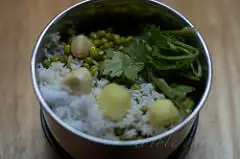
2. The batter will be coarse and you can adjust the thickness to your preference, not making it too watery. I prefer spongier pesarattu so keep my batter a bit on the thicker side – more thicker than regular dosa batter.
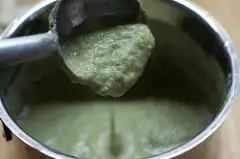
3. Heat a tawa and spread one ladle-full of batter into a dosa.
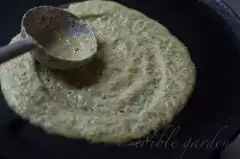
Spread it thinner for a crisper version, it’s entirely up to you. Drizzle with some oil and spread the minced onions on top (if using).
Sidenote: since I always use my left hand now for making dosas and such (the right hand being occupied by the camera), I think I can safely say I am becoming ambidextrous! Ah, the joys of food blogging.
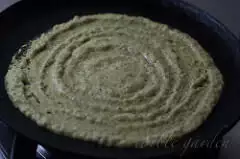
4. Flip over when the first side is cooked. You can also cover and cook the dosa without cooking, especially if you are serving the pesarattu with an upma filling (check notes).
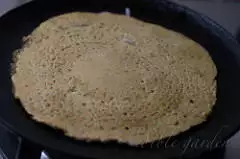
When both sides are cooked, remove from tawa and serve hot with spicy Andhra ginger chutney or allam pachadi. I love pesarattu with coconut-based chutneys like this coconut coriander chutney.

In pesrattu recipes, we confused … you mentioned whole green gram in ingredients list. but in method, you mentioned moong dhal . which is correct? moong or moong dhal ? moong and moong dhall is different no ?
green gram is called moong dal in hindi. it’s whole moong dal, not the split yellow type. sorry for the confusion
Hi Nags,
Longtime fan delurking to ask: do you have a recipe for allam pachadi?
Many thanks in advance!
i don’t have a great recipe actually 🙁 i don’t like allam pachadi much 😀 But I’ll try to share one soon which my good Hyderabadi friend’s mom passed to me
Good explanation of recipe.
One suggestion please… Attu in Telugu means Dosa in Tamil. So, one can call it as “Pesarattu” or even “Pesaradosa”, but not “Pesarattu dosa”.
Add onions, chilli pieces and jeera on top of Pesarattu while the dough is wet on pan. While filling, do it slowly, so that the toppings to not fall off too much.
Along with Upma and thick ginger chutney, Pesarattu is superb 🙂 For me, that’s the most tasty food on this planet. 🙂
Thank you for this note, I have changed the title to not call this recipe pesarattu dosa 🙂